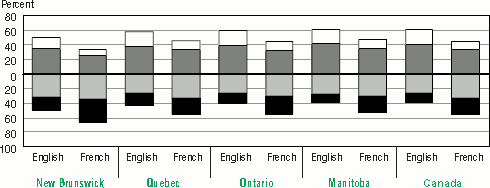
Figure 3.1
Source: International Adult Literacy Survey, 1994; International Adult Literacy and Skills Survey, 2003.
Outside Quebec, approximately 65 percent of Francophones chose to take the test in English. In New Brunswick, Ontario and Manitoba, the proportions are 33, 64 and 84 percent respectively (See Annex A Table 3.23). Francophones who were assessed in English have higher average scores in prose literacy than those who were assessed in French (See Annex A Table 3.31). Half of the Francophones living outside Quebec who took the test in English score below Level 3 on the prose literacy scale compared to 62 percent of those who took the test in French (See Annex A Table 3.17).
For the 65 percent of Francophones outside Quebec who were tested in English, about three out of five reported speaking English most often at home. Among this group of Francophones, those who speak English most often at home perform significantly better in prose literacy than those who speak French at home. About 17 percent of the Francophones speaking English at home place at Level 1 on the prose literacy scale, compared to 29 percent speaking French as their main language at home (See Annex A Table 3.18).
Because of the close relationship between proficiency and educational attainment, part of the explanation for literacy proficiency differences between language groups may be related to relative differences in their educational attainment. Indeed, in Quebec, there are no significant differences in prose literacy proficiency between Francophones and Anglophones at the same level of educational attainment (See Annex A Table 3.21).